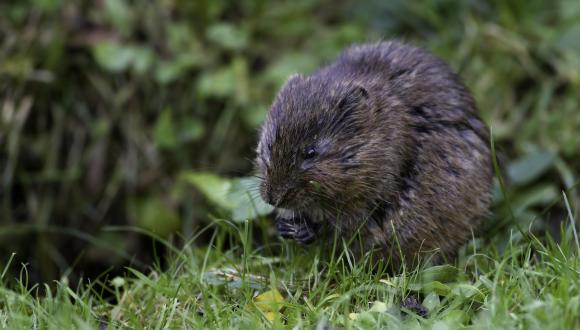Water voles
Water voles are the largest of Britain’s vole species, but this once abundant riverbank mammal is under threat from mink.
The water vole, or ‘water rat’ as it’s often mistakenly known, was once one of our most familiar riverside mammals. Sadly, it’s now one of our most threatened native mammals.
Scotland’s water voles are genetically distinct from most of those in England and Wales. The voles that colonised England and Wales following the last ice age were from South East Europe. Scotland’s voles appear to be descended from migrants from northern Iberia, with many having black fur rather than brown.
Water voles usually live beside bodies of water, where they feed on grasses and herbs growing on the banks. They dig their burrows here too. Water voles prefer sites with steep or stepped bank profiles into which they can burrow to create nest chambers above the water table. Soft soils are preferred.
In lowland areas, water voles occur beside:
- small, slow-flowing burns
- small backwaters
- canals
- ditch systems
- overgrown field drains
Some habitats may be in intensively farmed and urban areas. The best sites support a continuous swathe of tall grassy vegetation to provide food and cover for the voles.
But desperate losses in the lowlands mean that water voles are now mainly restricted to the smaller tributaries and headwaters of our upland rivers. Here they are found in narrow moorland burns and barren peat hags. The voles prefer areas with a thick layer of peat and lush vegetation.
Threats to water voles
The water vole is one of our most threatened native mammals. The species has seen a dramatic decline, particularly in the latter half of the 20th century.
Reasons for this decline include:
- habitat loss, degradation and fragmentation due to damaging riparian management – e.g. ‘hard’ river engineering techniques, over-grazing
- predation by American mink – a non-native invasive species
Water voles have many native predators, but none seem to threaten the survival of the species. However the non-native American mink is a highly adaptable opportunist predator, and female mink are small enough to follow voles into their burrows. A female mink with kits to feed may be a major threat to nearby water vole colonies. Mink are more scarce, or even absent, in upland areas.
A bank vole caught on a camera trap while feeding on a ball of fat.
Conservation of water voles
Water vole habitat can be damaged if grazing reduces the height of bankside vegetation. But the growth of dense scrub or trees is equally damaging – it leads to a decline in the grasses, reeds, sedges and rushes that the voles eat.
Water vole conservation relies on:
- maintaining tall grasses and herbs alongside the water body – fencing may help, but the growth of young trees and scrub must be prevented
- reducing the risk of mink colonisation – using measures such as habitat management to deter mink denning, and targeted mink control
Report a sighting
Do you know of a water vole colony? Knowledge of where water vole colonies are helps support conservation efforts, so if you would like to help please report your sightings.
Find out how to submit records of mammal sightings on The Mammal Society website.
Protection of water voles
Find out about the water vole as a protected species.
Read about water voles and licensing.
Read our guidance for planners and developers on protected animals.






